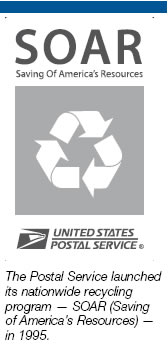Recycling and Reducing Waste
Each year the Postal Service recycles 1 million tons of paper, plastic, and other material, resulting in millions of dollars in revenue and cost avoidance. In 2007, $7.5 million was generated through recycling and waste prevention. The Postal Service also purchases more than $200 million in products with recycled content, including envelopes, packaging, and mail containers. New water-based inks used to print stamps are made from soybeans and contain no heavy metals. Stamps are produced with gum-free pressure sensitive adhesive to ease recycling. By switching to linerless labels on stamp coils, 700 tons of scrap paper were eliminated and disposal costs cut. A pilot partnership with New York City is helping the Postal Service evaluate new opportunities for recycling undeliverable Standard Mail, cardboard, shrink-wrap, and other materials. If the partnership proves successful, similar programs will be developed across the country.

The Solid and Hazardous Waste Program ensures that potentially hazardous and toxic wastes are handled in a way that safeguards public health and the environment and meets legal mandates. The Postal Service is reducing municipal solid waste and industrial waste through its partnership with EPA‘s WasteWise program, which challenges organizations to cut waste in innovative ways.
The Water Management program was formed to meet environmental standards for pollutant discharges, storm water runoff, and safe drinking water. It also supports efforts to minimize water usage. The Postal Service is committed to a two percent per year water reduction in its facilities using technology and best practices to measure and drive results. An overall water management strategy has been developed to ensure compliance with the requirements of the Clean Water and Safe Drinking Water Acts. In addition, Vehicle Maintenance Facilities will continue the policy of “zero pollutants” in the discharge from washing vehicles. Contracts include provisions to capture runoff and use environmentally-preferable products.
In February 2007 the Postal Service provided a report on its recycling efforts to the Government Accountability Office (GAO) in support of that agency‘s requirement to report on postal recycling activities. Supporting the use of recycled paper, and encouraging the recycling of waste paper have been postal strategies for almost two decades. The first Postal Service policy for recycling paper, including undeliverable Standard Mail, was issued in 1990. The program has evolved steadily since then. The Postal Service‘s effort now encompasses the full life-cycle of mail, and it works with industry partners such as the Direct Marketing Association to continue to increase the amount of recycled paper and other materials that are used to produce mail and packaging.

